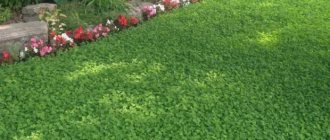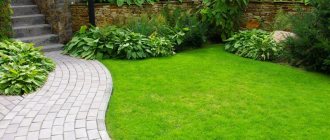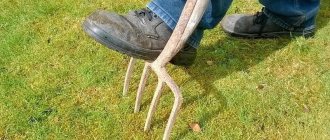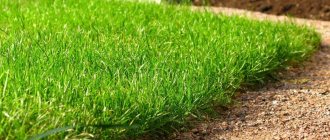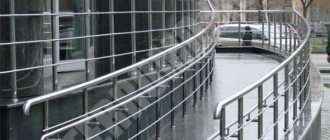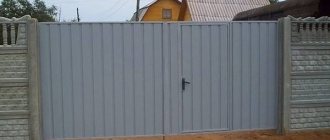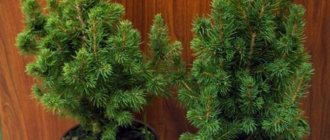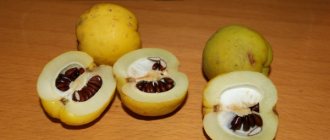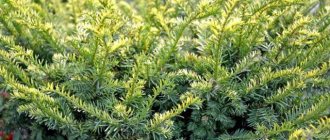Types of lawn grass
All kinds of seed mixtures are sold in specialized stores for summer residents. One mixture usually contains seeds from several plant species. This is necessary in order to create an ideal symbiosis of herbs. Plants have different rates of shoot growth and varying degrees of adaptability to environmental conditions. Not all shoots sprout, but with proper seed placement, the lawn will in any case be quite thick and beautiful.
Seed mixtures are selected separately for decorative lawns and sports fields. They differ primarily in the height of the grass. For decorative lawns, low plants up to 3 cm in height are used. Areas intended for active use are sown with grasses more than 4 cm in height.
In addition, there are universal lawn mixtures that include plants of different heights. If necessary, you can purchase grass for shaded areas, for example, for areas with high humidity. Lawn Lilliput is considered a universal seed mixture that can be used for sowing areas with any conditions.
Lilliputian lawn growing in the shade Source red-baron.spb.ru
Lawn for the lazy, or dwarf, aka midget
Why are lawns attractive for the lazy, otherwise known as dwarf or midget lawns?
This is primarily a reduction in maintenance time. Of course, any lawn, be it “normal” or dwarf, or low-growing lawn, or midget lawn, must be watered, fed, cleared of weeds and foreign debris, but “normal lawns” must be trimmed once a week. Only weather that is bad for grass growth—dry and hot—can extend the periods between cuttings to two weeks.
Mowing lawns, especially when they are large, requires a lot of time and the use of special lawn mowers.
Not all wealthy businessmen have time to spend a couple of hours every week cutting the grass, and you cannot skip cutting time, as the lawn will take on an unkempt appearance. And the type of lawn is the owner’s calling card, a sign of his material and financial wealth, his image. Therefore, the lawn has become popular for the lazy, or those who do not have time.
For urban conditions, it is also important to reduce the cost of mowing large areas in parks, squares, and streets.
A solution was found in the special selection of grasses that have a low growth rate, or are naturally short.
Such grass mixtures as Gnomeo, Pony, PYGMAEUS, Cottage Elite, Dwarf, or Lilliputian are specially bred for owners who do not have much time to care for the lawn. These are lawns for the lazy. Sometimes the owner is just too lazy to cut them every week.
These grass mixtures provide excellent, dense grass, not inferior to the best varieties of rolled lawns, but they are more flexible and suitable for growing in different climatic conditions. Moreover, the appearance of these lawns, subject to regular watering and fertilizing, meets all the requirements for a “ceremonial” appearance of the lawn.
The composition of these grass mixtures includes cereal grasses such as various types of fescue, meadow grass, and sometimes a mixture of clover.
Some types of clover, such as Microclover Pippolino, or white and creeping clover, may well serve as the basis for creating a clover lawn.
This type of lawn requires mowing only a couple of times per season. After flowering, the graceful white balls of the inflorescences turn brown and no longer decorate, but spoil the appearance of the lawn. These balls are located on short stalks and, after mowing, long, bare stems do not stick out from the lawn.
Fortunately, after cutting, clover blooms again and again takes on a beautiful appearance. Bees and bumblebees buzzing in search of honey take us back to distant childhood, or simply to the bosom of nature. Clover is an excellent honey plant, its honey has an exquisite taste, and after settling it hardens in the form of a granular, white mass. In England, large areas are occupied by clover.
The soil under clover leaves does not dry out for a long time, which attracts unwanted guests - slugs and snails.
After rain, such a lawn becomes slippery. While relaxing on a clover lawn, you need to look around so as not to sit on a bumblebee or a bee, which will be very unhappy with this.
The lifespan of such a lawn is about three years, so you need to take care to collect seeds from the largest heads in time and sow them into the bald spots that appear. You should not allow clover to be transferred to vegetable beds - it will be difficult to remove clover from them.
But clover is resistant to trampling, tolerates drought well, winters well and looks great, which makes up for all its shortcomings.
Some people like so-called Moorish lawns.
This is a blooming meadow in which some flowers replace others and flowering continues throughout the season - from spring to autumn. It contains many types of different annual grasses, specially selected to create a strip of continuous flowering, but such a lawn must be renewed every spring.
Ground cover shade-loving plants can improve small areas that are in the shade of trees or buildings. Here you can plant lilies of the valley, periwinkles and other similar plants. Small sunny lawns are an excellent place for phlox and similar flowers.
Grass mixtures are available for sale for almost all regions - from the North to the South. You can also create your own unique lawn by selecting seeds of various types of grasses, which are also commercially available.
What is lawn grass for the lazy
Lilliputian lawn, also called lazy person's grass, is a type of seed mixture that produces high-quality grass that requires almost no care or attention. The creators of the lawn for the lazy have bred a special variety of slow-growing, unpretentious grass. A huge number of scientists in Europe were engaged in this development before the “Lilliputian” acquired its characteristics.
The described mixture consists of seven types of meadow grass. All of them differ in the duration of the growth process, the ability to develop with minimal care and in a wide variety of climatic conditions. The dwarf lawn is supplied to Russia from Canada and European countries. All the seeds in the composition are very small, so the consumption is very small. To sow 1 square meter of land, 30 grams is enough. mixtures.
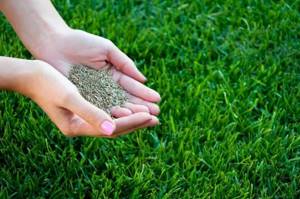
Lawn Grass Seeds Source yearofcleanwater.org
Main characteristics of a lawn for the lazy:
- The lawn tolerates loads well. You can walk on it, you can play sports on it, install heavy garden furniture, and move garden tools.
- Withstands sudden changes in temperature, frost and drought. In any conditions, this grass will grow quite actively.
- Taking care of your lawn is very easy. It should be cut only in the second year after sowing.
- The grass is very pleasant to the touch. All plants included in the composition have rather soft leaves.
- The lawn grows equally dense and bright in color even in the shade.
See also: Contacts of construction companies that offer landscaping services: landscaping, planting, installation of ponds, slides, rock gardens, rockeries, etc.
Advantages and disadvantages of Liliput lawn grass
- Among the advantages of the Liliput lawn, gardeners highlight the following:
- does not lose color and shape in any weather;
- drought and frost do not affect the appearance of the grass;
- plants in the mixture tolerate shade easily;
- the leaves of all plants are smooth and pleasant to the touch;
- includes slow-growing plants, which is why pruning is only needed for the next year;
- turns green even in winter.
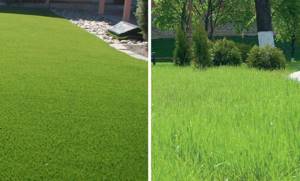
- But there are also some disadvantages:
- weeds often appear among the lawn and are characterized by intensive growth;
- In the second season, hummocks often appear on the site, spoiling the overall appearance;
- The seeds are small, so you need a lot of them for planting.
The Liliput lawn mixture is so unpretentious that it is actively used to decorate not only suburban areas, but also parks, squares, and cottage areas. It takes from 5 to 21 days for the green carpet to emerge and please the eye.
Composition of seed mixture
The lawn has excellent characteristics due to the fact that it contains plants that complement each other well.
Red fescue
Lilliputian lawn consists of 25% of this plant. This type of fescue is characterized by good tolerance to damage. It recovers very quickly, so the lawn always looks flawless. At the same time, red fescue tolerates low mowing and frost very well. One of its advantages is the uniformity of growth.
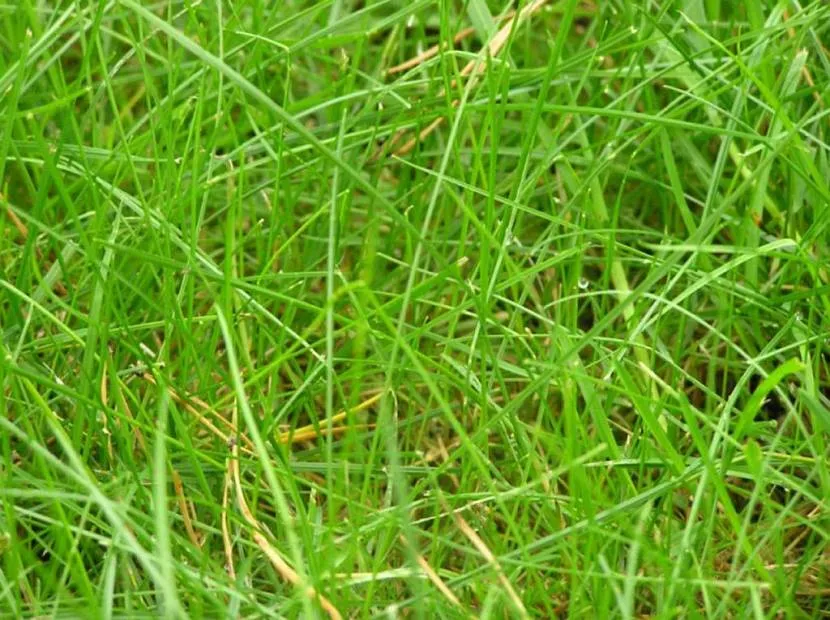
Red fescue Source mandarin-shop.ru
Meadow bluegrass
This herb contains about 20%. It is characterized by early emergence of shoots. Meadow bluegrass is a fairly resilient plant that adapts to any type of soil. It grows quickly and has a rich color.
Modified fescue
The plant, which is called Chancellor, was bred from red fescue specifically to become part of the Lilliputian grass composition. It is distinguished by a large number of above-ground shoots and rapid replacement. Contains 20% of the lazy lawn mixture.
Hairy fescue
Introduced into the composition for lawn density. This is the hardiest variety of fescue. Resistant to bad weather and high salt content in the soil.
Thin bentgrass
An unpretentious, stable plant necessary to give the lawn a rich color.
Bentgrass
There are few seeds of this plant in the mixture - about 5%. But even this amount is enough for the bentgrass to provide the lawn with rapid formation of turf. Has dense soft grass stand.

Bentgrass Source otomate.ru
Features of grass for the lazy
The composition of the multi-grass “Liliput” in percentage terms includes the following types of shoots:
- Red fescue SERGEI – 25% . It forms a dark green lawn at any time of the year and is resistant to frost and drought.
- Modified red fescue CHANCELLOR – 20%. This grass variety produces a large number of ground shoots. It is found only in combination with other types of fescue.
- Red fescue CAROUSEL – 10%. This variety produces the highest lawn density. Resistant to frost and drought.
- Red fescue MYSTIC – 10%
- Meadow bluegrass SOBRA/EVORA - 20%. Its grass stand is intensely green with hard turf. This is the most durable variety of grass; it lasts in the lawn for up to 3 years.
- Fine bentgrass HIGHLAND – 10%. The grass is unpretentious, resistant to trampling, and retains its green color even in winter.
- Bentgrass KROMI - 5%. This variety of low-growing grass grows very quickly, is drought-resistant and unpretentious.
Rules for sowing and care
Before seeding any lawn, you need to carry out some simple preparatory work. First, all debris, as well as tree roots and shrubs, should be removed from the area allocated for the lawn. After this, the site must be carefully dug up and left for a week. During this time, all weeds in the soil will germinate and should be removed.
Sowing
Seeds are planted to a depth of 1 to 3 cm. The same depth must be maintained throughout the sowing area. During the sowing process, the soil is leveled with a rake. After completion, it is recommended to water the area with plenty of water.
Immediately after entering the soil, the seeds can be destroyed by insects. In addition, a heavy downpour can wash them off the lawn. To avoid all this, you need to cover the area with film for several days.
Watering
If after a week the shoots sown on the lawn do not sprout, you should pay attention to the level of soil moisture. Too dry soil may not allow sprouts to emerge, so it must be carefully moistened with a sprinkler or watering equipment with a fine sprinkler. When the dwarf lawn is fully grown, it needs to be watered once every 2-3 days.
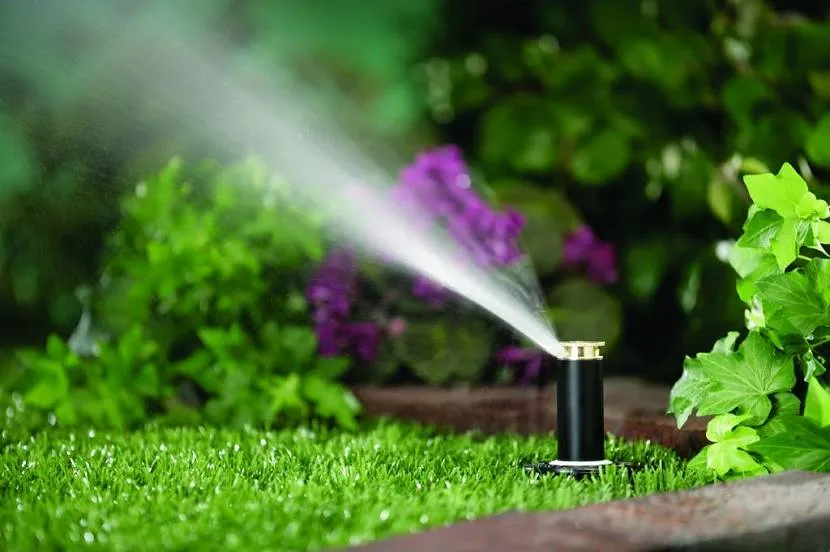
Automatic watering of the lawn on the site Source southernsprinklers.com
It should be remembered that during the period of intense summer heat, the lawn is watered after sunset or not watered at all. The fact is that drops of water increase the intensity of exposure to sunlight, and watered sheets can simply burn.
Low-growing (dwarf) lawns
A dwarf lawn is a lawn with enhanced decorative properties, consisting of special cereal grasses. Its peculiarity is that it grows back slowly after being cut. If the lawn was mowed when the grass shoots reached their maximum height, the next treatment will not be required for at least 10 months.
For dwarf lawns, thin-leaved, ornamental and slow-growing types of grasses are used. They have a powerful root system, so they are resistant to trampling and winter well.
Contains seeds of rhizomatous and loose-bush cereal grasses:
- varieties of meadow bluegrass (it gives the grass a beautiful look);
- varieties of bentgrass (especially bentgrass, which does not require cutting);
- varieties of red fescue (they tolerate shaded areas well).
The intensity of haircuts depends on weather conditions. If the weather is warm and humid, the lawn grows faster, and if the weather is cold and moisture is scarce, the lawn grows slower.
The root system of the grass mixture from such seeds develops rather slowly, so it will not be possible to quickly obtain a thick lawn.
You also need to take into account that creating a dwarf lawn will require fewer seeds than other types of lawn. Bluegrass and bentgrass have very small seeds.
The main lawn care is proper watering. In addition, you will need to fertilize the soil 1 or 2 times per season. Mineral fertilizers containing nitrogen, calcium and phosphorus are suitable.
If the soil in the area has a poor content of organic matter (humus), it is worth carrying out work to improve its properties, for example, bringing in peat or a peat-sand mixture.
Important! Grass mixtures for “lazy lawns” should not contain ryegrass, as it grows back quickly after mowing.
To create a low-growing lawn, you can use grass mixtures with the addition of microclover. This plant blooms twice a year, needs almost no pruning, and does not require frequent watering or fertilizing. However, the mass fraction of clover should not exceed 10% of the mixture. Don't forget that clover attracts bees and bumblebees to your lawn. Another drawback of the variety is the accumulation of dried flowers.
Lawn grass mixtures are sold in our online store in packages ranging in size from 1 to 20 kg. The cost depends on the volume and type of grass mixture. We deliver goods throughout Moscow and other regions. There is a possibility of self-pickup.
Video description
Overseeding lawn grass:
Repair
It often happens that by the end of summer the lawn partially or completely loses its ideal appearance. To correct the situation, you must first clean it. Everything needs to be removed - debris, weeds, anthills, etc. Subsequent actions depend on the type of damage. So, if depressions and hummocks have formed on the lawn, you need to cut through the turf to its entire depth in places of unevenness, fold its edges to the side, and then either remove excess soil or add more soil. Upon completion of this work, the turf is returned to its place.
If a bald spot has formed, then it is necessary to remove the damaged turf in this place and replace it with a new one. You can simply use the partial seeding method. Repairing lawn edges is done by removing damaged grass and replacing it with sprouted turf and fertile soil.
How to lay a lawn correctly
Sowing a lawn begins with choosing a place for it. First, the location of the lawn is determined and its type is selected: will it be an ordinary lawn, parterre, flowering, sports, etc. Then the area of the future green meadow is determined: this is done to determine the required number of seeds, volume of soil and fertilizers. In addition, you need to have a good idea of how the lawn will look in composition with the rest of the garden elements - paths, buildings, plantings. Particular attention must be paid to where the boundaries of the future lawn will be: it should be convenient to mow, and the lawn itself should not grow into flower beds.
It is believed that the lawn should have a rectangular shape, but this is not at all necessary. You can sow a lawn in the form of a grass path, which will separate, for example, two wide borders with flowers. The lawn can be shaped into a circle, semicircle, oval or arbitrary. Semicircles will create a feeling of harmony and completeness, and plants will add color and give the garden shape, covering uneven areas between the arcs.
Planting an oval-shaped lawn in a long, narrow garden will improve the visual impact, add perspective to the garden and make the space appear larger as an oval lawn will appear round in perspective. To accentuate this effect, an oval lawn can be surrounded by deciduous plants with pointed stems.
After the shape and location of the future lawn has been determined, the soil is analyzed and prepared, since this is the key to the successful germination of grasses and their further development.
Experts advise preparing the soil for sowing a lawn in the fall, leaving it for the winter, or in early spring. You can prepare the soil just before sowing, but in this case, after digging, you must allow the soil to settle.
So, when starting to sow a lawn, the area needs to be thoroughly cleared, debris removed and weeds destroyed.
Weeds not only interfere with the growth of grasses, but can also be a source of diseases that spoil the lawn. To destroy them, sometimes it is enough to dig up the ground. Another option is to treat the area with special chemicals.
When everything is ready, you need to form the topography of the future lawn. The lawn should be flat, but may have a slight slope (1-3%) to facilitate surface water drainage. Larger lawns can be given more pronounced slopes, but not exceeding 30%.
At this stage, the fertile layer is prepared. First, they arrange a drainage system; it is also recommended to lay all the necessary communications: for example, install an underground irrigation system and a power supply system.
The thickness of the fertile layer for the normal development of the lawn must be at least 15 cm. In a particular area, due to construction work associated with uprooting trees, laying communications and similar work, lower layers of soil, devoid of nutrients, “washed out” may appear on the surface. It is very difficult to grow a high-quality lawn on such soil, so the soil is often replaced. The existing soil is dug up and leveled, and then the soil is improved depending on its characteristics.
Soil preparation, depending on the type of lawn, has its own nuances: for example, for sowing a Moorish lawn, it may be less fertile, but it is especially important to thoroughly clear it of weeds.
The components of the soil mixture are mixed and sealed very carefully. The soil is loosened to a depth of about 40 cm (to the depth of a shovel) so that the lower layers do not move upward (as, for example, during deep layer-by-layer digging). In this case, parts of plants that have survived chemical treatment, especially their roots, should be removed from the ground.
Then the entire surface is sprinkled with humus soil (for example, high-quality compost), after which the entire area is carefully leveled. Large earthen clods are broken up, and then the entire area of the future lawn is combed crosswise twice with a garden rake.
Since in most cases the lawn borders paths, flower beds or borders, its edge must be secured (otherwise it will be very difficult to mow the edges of the lawn later). To secure the edges of the lawn, you can use gravel, stone borders, tiles, etc.
When preparing the soil for a future lawn, you should pay great attention to the evenness of its surface, on which no bumps or holes should remain. If this is allowed, water will begin to stagnate in the holes in the lawn and the grass will become wet; and the bumps will make it difficult for the lawn mower to operate. In most cases, it is necessary to repeat the tamping procedure several times (each time after the work is completed, the area is watered abundantly and the next stage is started after the soil has completely settled).
By the way, experts believe that the prepared soil should be left for some time (from several months to a year) so that natural shrinkage of the soil occurs and all surface defects are revealed. For example, weeds inevitably sprout on freshly cultivated soil. They will need to be removed by loosening or treating the soil with chemicals.
When sowing a lawn, it is important not to forget to properly shape its edges - otherwise you will have to constantly carry out the labor-intensive and painstaking work of cutting the unmowed edges of the lawn.
Near supporting walls, fences, stairs, and buildings, designers recommend leaving a small strip unsown with grass, on which you can lay tiles or sprinkle it with gravel.
It is recommended to leave so-called trunk circles near trees and bushes, which will protect tree trunks from damage, mulch them with pieces of bark or gravel, or plant plants that provide turf. Young trees equipped with a trunk circle grow better because their roots do not have to compete with grass roots for water and minerals. The lawn can be separated from flower beds by a border made of stones, bricks, tiles, plastic or wooden slats.
About a week before sowing the seeds, experts advise adding fertilizer to the soil and watering it abundantly.
Lawn sowing is usually carried out from the moment the last snow melts until the end of August. At a later date, experts do not recommend sowing the lawn, since the plants will not have time to store enough necessary substances for wintering. This may result in the lawn having to be reseeded.
The grass mixture for sowing is selected depending on the desired type of lawn and the area of their intended sowing.
The number of seeds is usually calculated depending on the composition of the grass mixture. Typically, on average, about 20-30 g of seeds are used per 1 m2 of lawn (for flat areas) or 30-50 g for slopes, where denser sowing is recommended.
You can seed your lawn throughout the summer, but only if you water it regularly: Usually seeding is done in one day. It is best to sow the lawn on a calm day, so that the work is not interfered with by wind or rain and you can move around the soil without fear of ruining the future lawn.
Sowing the lawn begins by loosening the soil a little (no more than 3-4 cm deep). This can be done with the tips of the tines of a garden rake, passing once along and then across.
Then the required amount of seeds is placed in a plastic container and mixed well. Thorough mixing is especially necessary if a grass mixture of different cereals is used for sowing. Seed mixing continues throughout sowing to ensure uniform distribution of different types of grass throughout the lawn. Seeds are scattered using a special seeder or planted manually.
The seeds are sown, moving along the future lawn along the “snake” line with your back forward, this allows you to visually adjust the sowing density and keep the work under control. The second time the section is passed along a winding line located perpendicular to the first route; the third and fourth are diagonal. After sowing the lawn, its surface can be rolled with a hand roller (however, many gardeners believe that this is not necessary).
In any case, after the seeds are sown, they need to be embedded in the soil. Some advise using a garden rake or mulching the seeds (for mulching, it is recommended to sprinkle them with a thin, loose layer of plant soil with sand no more than 3 cm high). It is believed that mulching creates a favorable microclimate, provides moisture protection and accelerates the growth of grass several times, enhancing the beauty of the lawn “carpet”; mulching is also very useful in that it protects seeds from birds.
Having finished sowing the lawn, it is necessary to carry out uniform and careful watering (sprinkling). It is necessary to water with thin streams of water, from a watering can, or using special watering installations, in order to avoid washing out the seeds and disturbing the top layer of soil. For faster emergence of uniform seedlings, you need to water the lawn every day, in the morning or evening.
The first mowing of the lawn is carried out after the green sprouts have grown by 10-15 cm, not earlier, in order to allow the grass to get stronger.

